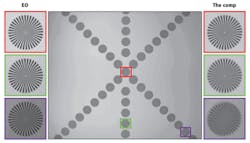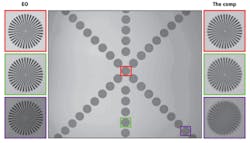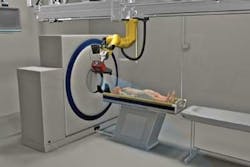3-D IMAGING: Stereo vision uses a single lens/camera combination
Three-dimensional imaging is useful in a range of machine-vision applications, including robotic guidance, medical endoscopy, and military aircraft refueling systems. In many of these applications, dual-camera systems capture two disparate images of the scene and then use epipolar geometry to determine depth information. While dual-camera systems are the most common way to capture stereo image pairs, other methods do exist.
For example, ISee3D (Toronto, ON, Canada; www.isee3d.com) has developed a stereo camera that uses a single lens and single camera in combination with a mechanical or liquid-crystal optical switching mechanism. By placing this mechanism between the lens and camera to occlude one half of the lens, the optical switch captures both a left and right image perspective sequentially.
The technology was first applied to 3-D endoscopes during a number of minimally invasive human surgeries, which showed the advantages of using high-quality, real-time 3-D video imagery for a critical telepresence application. The endoscopy trials showed the technology to be particularly useful in extremely tight cavities, where it is awkward or impossible to position two lenses.
It should be noted that capturing stereoscopic images with a single lens has advantages beyond the obvious ability to reduce the space required for the lenses. It also ensures perfectly matched image pairs without requiring extensive post-capture software processing. The perfect matching is especially useful in applications where there is a human end viewer requiring real-time display, as it ensures that there are none of the misalignments or mismatches between lenses that can cause the headaches, dizziness, or nausea sometimes associated with prolonged exposure to 3-D.
In the design of the mechanical switch (as used in the original endoscopy application), an opaque leaf is supported on one end of an arm that is attached to a magnetic armature with a fulcrum positioned between the two (see Fig. 1). This armature is controlled by two damped electromagnets that are electronically switched to move the leaf across the optical path. To perform stereo imaging at video rates, the optical switch is moved during the vertical blanking interval of the cameras sensor, and the left and right exposures taken at half the frame rate of 33.3 ms (16.7 ms).
Because the opaque leaf divides the image path into a left and right perspective, the resulting images represent a stereo pair of a single-image frame. The resulting image pairs lose one f/# of light, since the aperture of the camera/lens system is effectively halved for each stereo image. However, the recent increase in sensor capability dramatically reduces the impact of this lost f/#, with 8 and 10 Mpixel sensors able to deliver higher than HD resolution with very low light sensitivity.
To demonstrate the potential of this technology across a wide variety of camera types and applications, ISee3D contracted a large US engineering firm to develop an HD 3-D prototype system using a liquid-crystal optical switch and a high-resolution CCD camera. This camera is currently being used to demonstrate the capture and display of real-time, high-definition 3-D content (see Fig. 2).
FIGURE 2. The ISee3D prototype camera has an externally mounted optical switch. A 4-Mpixel DALSA (Waterloo, ON, Canada) camera is triggered by a Camera Link Meteor, PC-based frame grabber from Matrox Imaging (Dorval, QC, Canada). Timing signals from the frame grabber are also used to synchronize the optical switch so that stereo pairs are obtained at frame rates. Running at 60 frames/s, the liquid-crystal optical switch can be used to generate stereo pairs at 30 frames/s.
ISee3D engages in licensing of its core technology and is open to working with firms worldwide to develop products incorporating its single lens 3-D technology.


